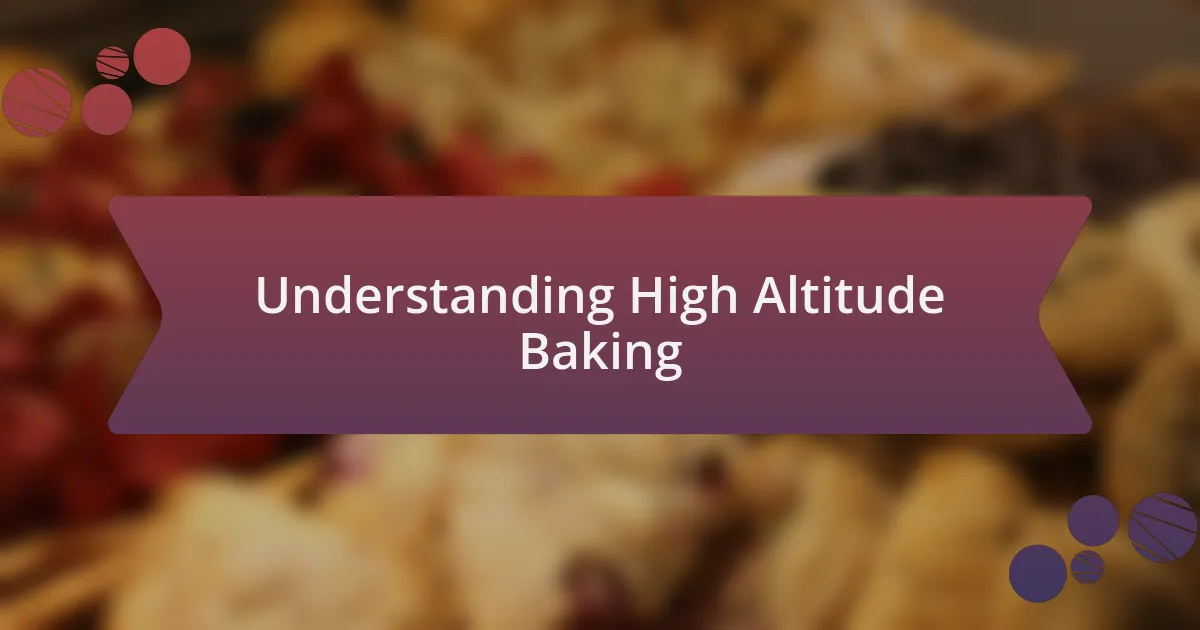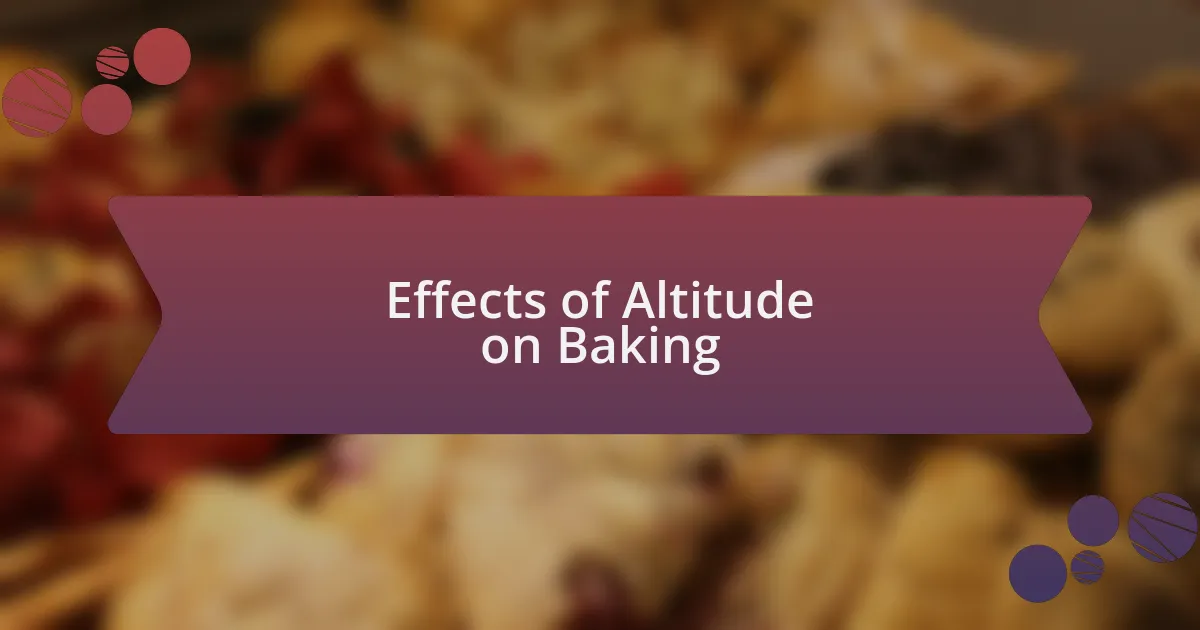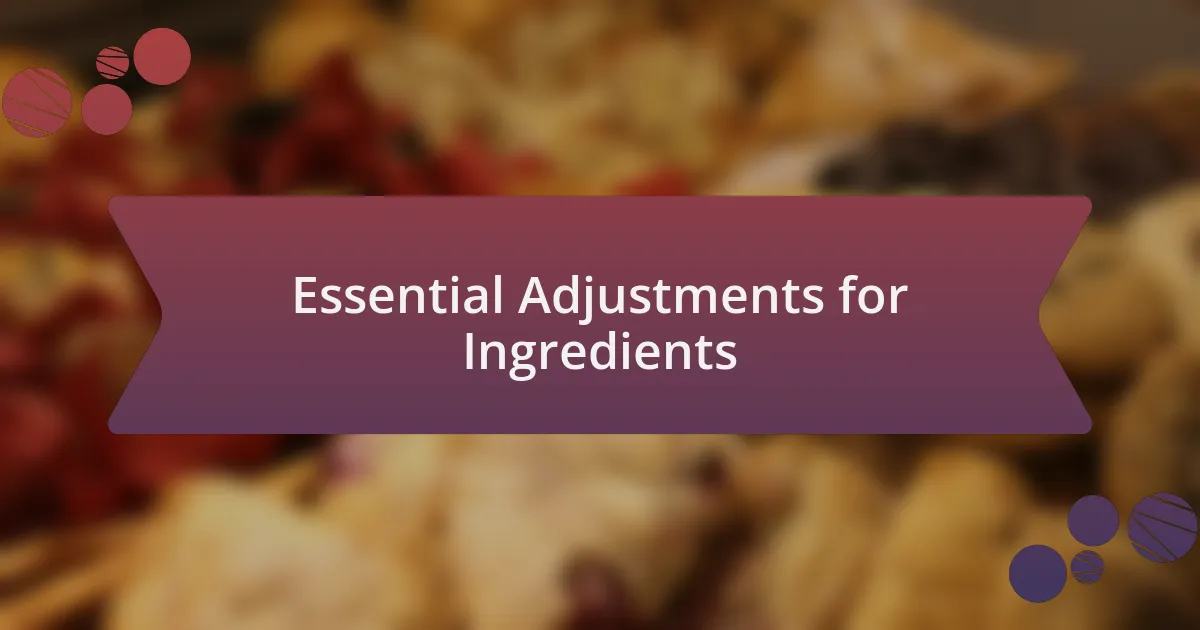Key takeaways:
- High altitude baking requires adjustments due to decreased atmospheric pressure, affecting how ingredients rise and retain moisture.
- Key ingredient adjustments include reducing sugar, baking powder, and increasing liquid to prevent dry and dense baked goods.
- Common mistakes include not adjusting flour quantities and oven temperatures, which can lead to undesirable textures and baking outcomes.
- Successful high altitude recipes can involve trial and error, but practice leads to improved understanding and confidence in baking techniques.

Understanding High Altitude Baking
Baking at high altitudes, typically above 3,500 feet, can feel like a science experiment where the rules change. I remember the first time I attempted to bake cookies in the mountains; they spread out like pancakes instead of holding their shape. It was a real eye-opener—how could something so simple go so wrong?
One major factor is the decreased atmospheric pressure at higher altitudes. This causes baked goods to rise faster and, often, unevenly. Have you ever wondered why your cakes turn out dry or your bread becomes crumbly? It’s often because the balance of ingredients is off due to that lower pressure.
Understanding the need for adjustments becomes essential to ensure success in your baking endeavors. For instance, I’ve learned to reduce sugar and increase the liquid in recipes. It took a few trials, but now I can confidently whip up a batch of muffins that are light and delicious, even at elevation. Have you faced similar challenges in your baking? The key lies in embracing those adjustments and finding what works best for your unique environment.

Effects of Altitude on Baking
Baking at high altitudes presents unique challenges that can surprise even experienced bakers. I remember the first time I made a sponge cake; it rose to towering heights, only to collapse in a sad, deflated heap once I took it out of the oven. That experience taught me just how rapidly the leavening agents work in thinner air, leading to an uneven rise if not properly adjusted.
Another unexpected twist I faced was how my timing for baking changed in the mountains. At sea level, I could almost set my watch to a batch of brownies, but up high, I discovered they needed a few extra minutes in the oven to set properly. Isn’t it fascinating how something as simple as altitude can alter the very essence of a recipe?
I found that adjusting baking times and temperatures isn’t just about managing ingredients; it’s about developing a new intuition. Each time I venture into this mountain baking journey, I earn a little more confidence and wisdom. Have you ever felt that thrill when perfecting a recipe after multiple attempts? It’s as though each success takes you one step closer to becoming a seasoned high-altitude baker.

Essential Adjustments for Ingredients
Baking powder and baking soda are your best friends at high altitudes, but their potency changes drastically. I recall a time when I followed a standard cookie recipe and ended up with pancake-like results; the leavening agents were simply too powerful. I learned that reducing the amount of baking powder or soda can help ensure that my cookies rise beautifully without overshooting.
When it comes to sugar, I’ve discovered that you might need to adjust the sweetness in your recipes. At first, I thought adding more sugar would enhance flavors, but my brownies became too sweet to enjoy. Instead, I learned to cut back slightly on sugar to create a balanced flavor, allowing the other ingredients to shine. Have you ever overdone it with sugar and regretted it later?
Don’t forget about liquid ingredients either! I distinctly remember a bread recipe that required an additional splash of water; otherwise, it would have turned out dry and crumbly. High altitudes can cause moisture to evaporate more quickly, so it’s essential to add a bit more liquid to your mixes. Every adjustment I make is another step in my journey of discovery and has taught me that baking is both an art and a science, especially in the mountains.

My Favorite High Altitude Recipes
When it comes to high altitude baking, one of my go-to recipes is a classic carrot cake. I remember the first time I attempted it, and I was left with a dense mess instead of the light, fluffy treat I envisioned. By adjusting the liquids and reducing the baking powder, I was able to produce a moist, flavorful cake that rose perfectly. There’s something magical about the aroma of warm spices filling the kitchen as it bakes; it truly makes it worth the effort.
Another favorite of mine is homemade pizza dough. The first few times I made it at high altitude, my dough wouldn’t rise enough, resulting in a flat base that could barely hold toppings. After tweaking the yeast amount and letting the dough rest longer, I finally achieved that perfect airy crust. Have you ever taken a bite of a pizza and thought, “This is exactly how it should taste?” That’s what I aim for with every batch.
Lastly, I can’t recommend my coconut macaroons enough. As I experimented, I learned the importance of balancing the egg whites; too much would cause them to spread too thin. I distinctly recall the look on my friends’ faces when they took their first bites—pure joy. There’s nothing quite like sharing a baking success, especially when it comes from adapting recipes that truly resonate with the unique challenges of high-altitude baking.

Common Mistakes to Avoid
One common mistake I often see is not adjusting the flour quantity. During my early baking days at high altitude, I assumed my standard recipe flour measurement would suffice. Instead, I ended up with heavy, dry cakes that were far from appetizing. By simply reducing the flour by a few tablespoons, I was able to create lighter, fluffier baked goods. Did you know that extra flour can lead to a chewy texture and collapse? Trust me, it’s worth experimenting with to achieve that perfect consistency.
Another pitfall is overlooking the importance of oven temperature. When I first began baking in higher elevations, my oven seemed to bake cooler than I expected. I remember checking on a batch of cookies only to find them barely golden. Increasing the temperature by about 25 degrees Fahrenheit helped me achieve the crispy edges I crave. Have you ever sacrificed quality for time, thinking a quick bake would suffice? I can tell you from experience that patience pays off in the end, especially at altitude.
Lastly, many bakers forget about the significance of adjusting the leavening agents. In my initial attempts, I was too eager to follow recipes to the letter, leading to desserts that fell flat. I learned that reducing baking powder or baking soda helps prevent that dreaded sinking effect. Has this ever happened to you? Finding that balance can be tricky, but it’s a game changer for achieving delectable results.